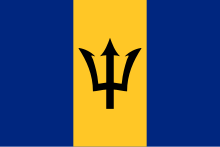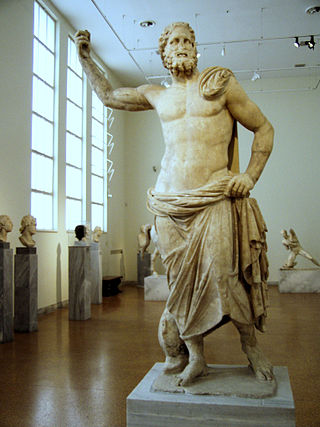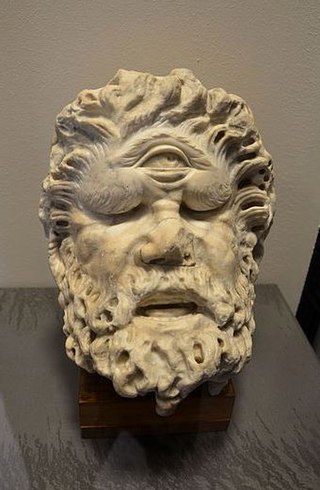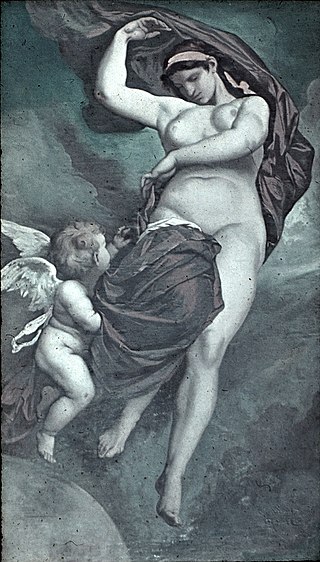
The trident of Poseidon and his Roman equivalent, Neptune, has been their traditional divine attribute in many ancient depictions. Poseidon's trident was crafted by the Cyclopes.

The trident of Poseidon and his Roman equivalent, Neptune, has been their traditional divine attribute in many ancient depictions. Poseidon's trident was crafted by the Cyclopes.

In Greek mythology, Poseidon's trident was forged by the cyclopes according to Pseudo-Apollodorus's Bibliotheke . [1] [2] [lower-alpha 1]
Poseidon wields his trident on a number of occasions. He used his trident to strike a rock upon the hill of the Acropolis, producing a well of seawater, in what developed into a contest between him and Athena over possession of Attica. When he lost, Poseidon used the trident to dry out the land so they had no water. The well was later to be called the Erechtheis. [3] [4] [5] There is further myth that Poseidon (Neptune) produced a horse by striking the earth with the trident, in order to bolster his claim, [6] but there is no attestation for this among Greek writers. [7] The alleged trident print on a rock and the sea well within the Erechtheion were witnessed by the geographer Pausanias while visiting Athens. [lower-alpha 2] [8] [3] [7]
In another myth, Poseidon creates a spring or springs with the strike of his trident to reward Amymone for her encounter with him. [9] In a version of another myth Poseidon wields his trident to scare off a satyr who tries to rape Amymone after she mistakenly hits him with a hunting spear. [9]
There is also a myth where Poseidon touches the island of Delos with his trident, affixing it firmly to the sea floor. [10] Another myth tells how Poseidon, enraged by sacrilegious behavior of Ajax the Lesser, uses the trident to split the rock to which Ajax was clinging.
The oldest coins of Poseidonia from the 6th century BC depict a trident wielded by Poseidon in his right hand, similar to Zeus's thunderbolt. An Attican red figure kylix from c. 475 BC depicts Poseidon killing the Giant Polybotes with his trident. [11]
According to the second and third Vatican Mythographer, Neptune's trident symbolizes the three properties of water: liquidity, fecundity and drinkability. [12]
The trident of Neptune was viewed by Roman scholar Maurus Servius Honoratus as three-pronged because "the sea is said to be a third part of the world, or because there are three kinds of water: seas, streams and rivers". [12]
The view shared by Friedrich Wieseler, E. M. W. Tillyard and several other researchers is that Poseidon's trident is a fish spear, typical for coast-dwelling Greeks. [13]
According to Robert Graves, however, both Poseidon's trident and Zeus's thunderbolt were originally a sacred labrys, but later distinguished from each other when Poseidon became god of the sea, while Zeus claimed the right to the thunderbolt. [14]
According to a competing proposal by H. B. Walters, Poseidon's trident is derived from Zeus's lotus scepter, with Poseidon being Zeus in his marine aspect. [13]

In present times, Poseidon's trident is a recurring symbol. It appears on the coat of arms of Liverpool City Council, on the seal of the Greek Navy, and on the crest of the Delta Delta Delta sorority. It is a recurring motif in the US military, being featured on the crest of the United States Navy SEALs and on the badge of USS John S. McCain. A series of American fleet ballistic missiles Trident is named after Neptune's trident, [15] as well as Operation Neptune Spear.
The personification of Great Britain, Britannia is depicted with the trident of Poseidon as a symbol of naval power. The broken tip of the trident appears on the flag of Barbados. In this instance, the reference is to its use as Britannia's trident, broken to symbolise the end of Britain's colonial rule.
The logo of car manufacturer Maserati is based on the trident from the statue of Neptune in Bologna. [16]
The trident also appears multiple times in popular culture. Poseidon's trident is owned by King Triton (Poseidon's son) in Disney's 1989 animated film The Little Mermaid and its sequels and spinoffs. Poseidon's Trident is a magical artifact with destructive powers in Michael Livingston's 2015 historical fantasy novel The Shards of Heaven . [17] [18] Disney's Pirates of the Caribbean franchise also referenced Jack Sparrow's adventures with the Trident of Poseidon through the Jack Sparrow prequel book series and later in the fifth film Pirates of the Caribbean: Dead Men Tell No Tales .

Poseidon is one of the Twelve Olympians in ancient Greek religion and mythology, presiding over the sea, storms, earthquakes and horses. He was the protector of seafarers and the guardian of many Hellenic cities and colonies. In pre-Olympian Bronze Age Greece, Poseidon was venerated as a chief deity at Pylos and Thebes, with the cult title "earth shaker"; in the myths of isolated Arcadia, he is related to Demeter and Persephone and was venerated as a horse, and as a god of the waters. Poseidon maintained both associations among most Greeks: he was regarded as the tamer or father of horses, who, with a strike of his trident, created springs. His Roman equivalent is Neptune.

In Greek mythology and later Roman mythology, the Cyclopes are giant one-eyed creatures. Three groups of Cyclopes can be distinguished. In Hesiod's Theogony, the Cyclopes are the three brothers Brontes, Steropes, and Arges, who made for Zeus his weapon the thunderbolt. In Homer's Odyssey, they are an uncivilized group of shepherds, the brethren of Polyphemus encountered by Odysseus. Cyclopes were also famous as the builders of the Cyclopean walls of Mycenae and Tiryns.
Asopus is the name of four different rivers in Greece and one in Turkey. In Greek mythology, it was also the name of the gods of those rivers. Zeus carried off Aegina, Asopus' daughter, and Sisyphus, who had witnessed the act, told Asopus that he could reveal the identity of the person who had abducted Aegina, but in return Asopus would have to provide a perennial fountain of water at Corinth, Sisyphus' city. Accordingly, Asopus produced a fountain at Corinth, and pursued Zeus, but had to retreat for fear of Zeus' terrible thunderbolt.

Erechtheus in Greek mythology was a king of Athens, the founder of the polis and, in his role as god, attached to Poseidon, as "Poseidon Erechtheus". The name Erichthonius is carried by a son of Erechtheus, but Plutarch conflated the two names in the myth of the begetting of Erechtheus.

In Greek mythology, Alcyone and Ceyx were a wife and husband who incurred the wrath of the god Zeus for their romantic hubris.

In Greek mythology, Phoroneus was a culture-hero of the Argolid, fire-bringer, law giver, and primordial king of Argos.

In Greek mythology, Amphiaraus or Amphiaraos was the son of Oicles, a seer, and one of the leaders of the Seven against Thebes. Amphiaraus at first refused to go with Adrastus on this expedition against Thebes as he foresaw the death of everyone who joined the expedition. His wife, Eriphyle, eventually compelled him to go.
In Greek mythology, Arcas was a hunter who became king of Arcadia. He was remembered for having taught people the arts of weaving and baking bread and for spreading agriculture to Arcadia.
In Greek mythology, Campe or Kampe was a female monster. She was the guard, in Tartarus, of the Cyclopes and Hecatoncheires, whom Uranus had imprisoned there. When it was prophesied to Zeus that he would be victorious in the Titanomachy—the great war against the Titans—with the help of Campe's prisoners, he killed Campe, freeing the Cyclopes and Hecatoncheires, who then helped Zeus defeat Cronus.

Cecrops was a mythical king of Attica which derived from him its name Cecropia, having previously borne the name of Acte or Actice. He was the founder and the first king of Athens itself though preceded in the region by the earth-born king Actaeus of Attica. Cecrops was a culture hero, teaching the Athenians marriage, reading and writing, and ceremonial burial.
In Greek mythology, Acrisius was a king of Argos. He was the grandfather of the famous Greek demi-god Perseus.
Phocus was the name of the eponymous hero of Phocis in Greek mythology. Ancient sources relate of more than one figure of this name, and of these at least two are explicitly said to have had Phocis named after them.
In Greek mythology, Pelasgus was the eponymous ancestor of the Pelasgians, the mythical inhabitants of Greece who established the worship of the Dodonaean Zeus, Hephaestus, the Cabeiri, and other divinities. In the different parts of the country once occupied by Pelasgians, there existed different traditions as to the origin and connection of Pelasgus. Some ancient Greeks even used to believe that he was the first man.

In Greek mythology, Idas, was a Messenian prince. He was one of the Argonauts, a participant in the hunt for the Calydonian Boar and contender with the gods. Idas was described as keen and spirited.

A trident is a three-pronged spear. It is used for spear fishing and historically as a polearm.

In Greek mythology, Lycaon was a king of Arcadia who, in the most popular version of the myth, killed and cooked his son Nyctimus and served him to Zeus, to see whether the god was sufficiently all-knowing to recognize human flesh. Disgusted, Zeus transformed Lycaon into a wolf and killed his offspring; Nyctimus was restored to life.

In Greek mythology, the Danaïdes, also Danaides or Danaids, were the fifty daughters of Danaus. In the Metamorphoses, Ovid refers to them as the Belides after their grandfather Belus. They were to marry the 50 sons of Danaus' twin brother Aegyptus, a mythical king of Egypt. In the most common version of the myth, all but one of them killed their husbands on their wedding night and are condemned to spend eternity carrying water in a sieve or perforated device. In the classical tradition, they came to represent the futility of a repetitive task that can never be completed.

In Greek mythology, Gaia, also spelled Gaea, is the personification of Earth. Gaia is the ancestral mother—sometimes parthenogenic—of all life. She is the mother of Uranus (Sky), from whose sexual union she bore the Titans, the Cyclopes, and the Giants; as well as of Pontus (Sea), from whose union she bore the primordial sea gods. Her equivalent in the Roman pantheon was Terra.

In Greek mythology, Polybotes was one of the giants, the offspring of Gaia (Earth) and Uranus (Sky). He fought Poseidon during the Gigantomachy, the war between the giants and the gods.
In Greek mythology, the name Orchomenus may refer to: